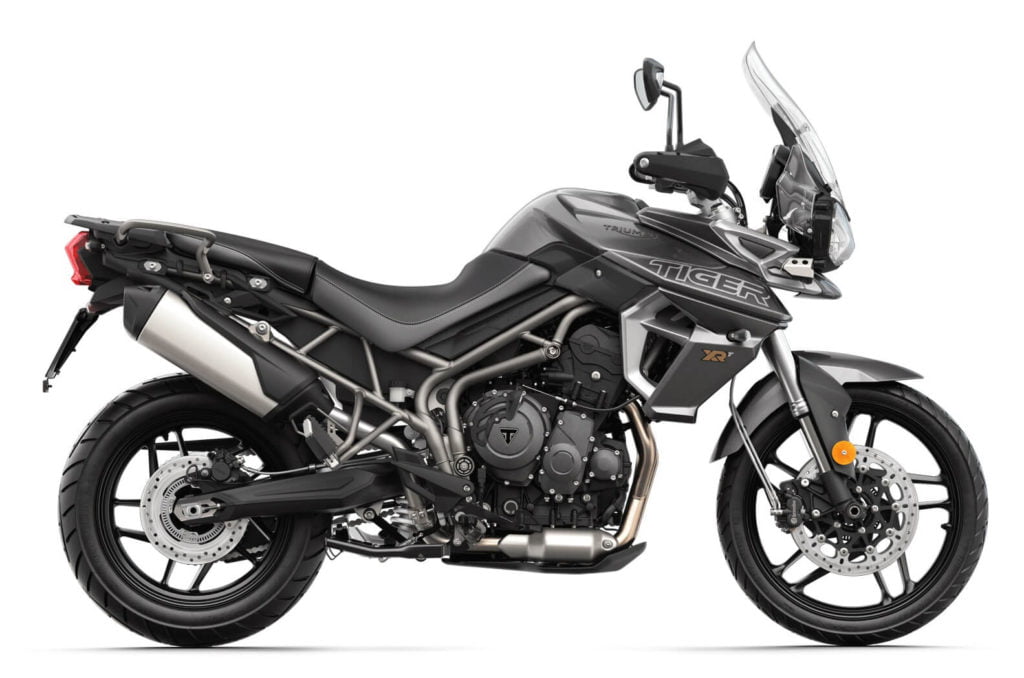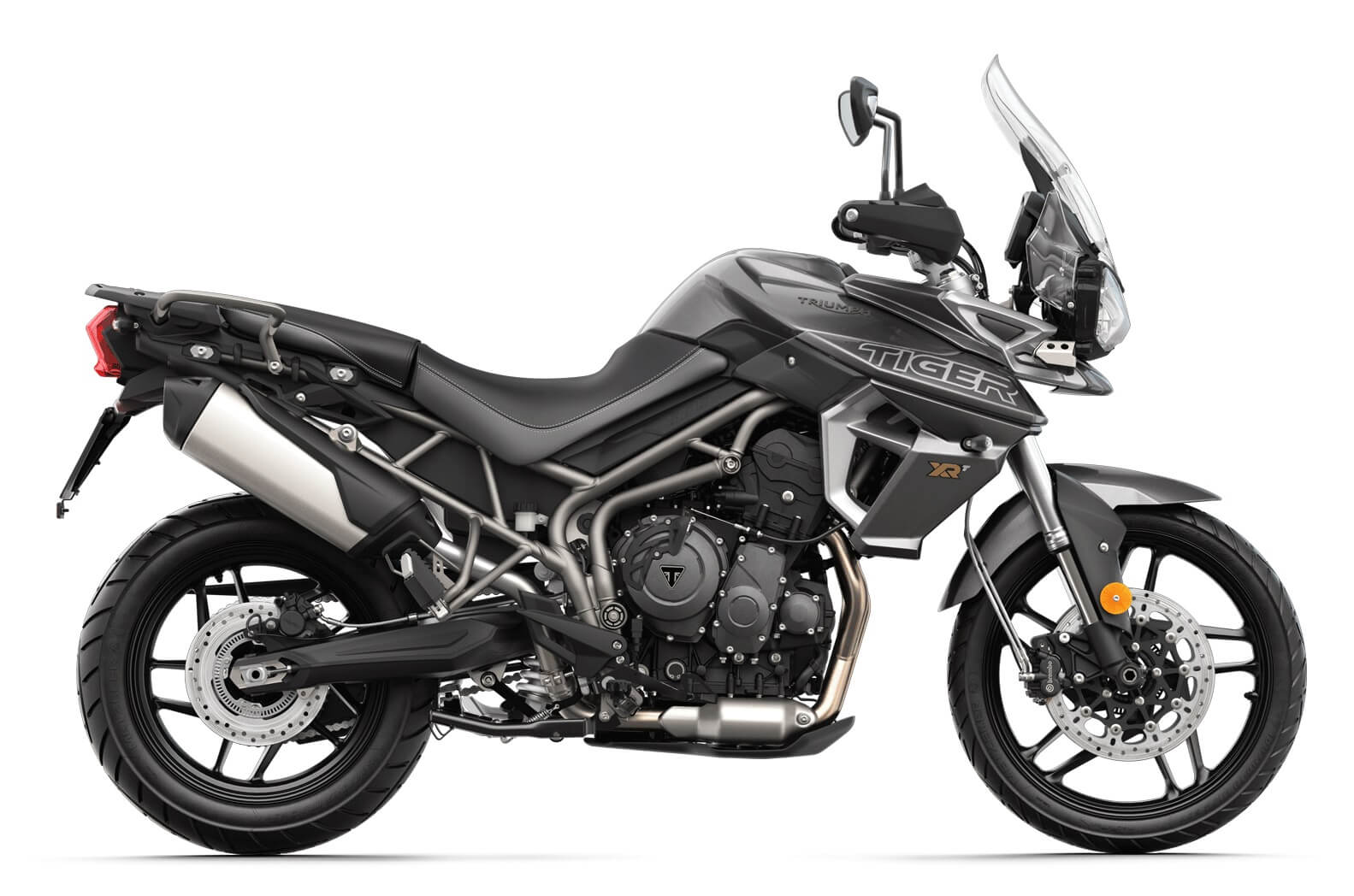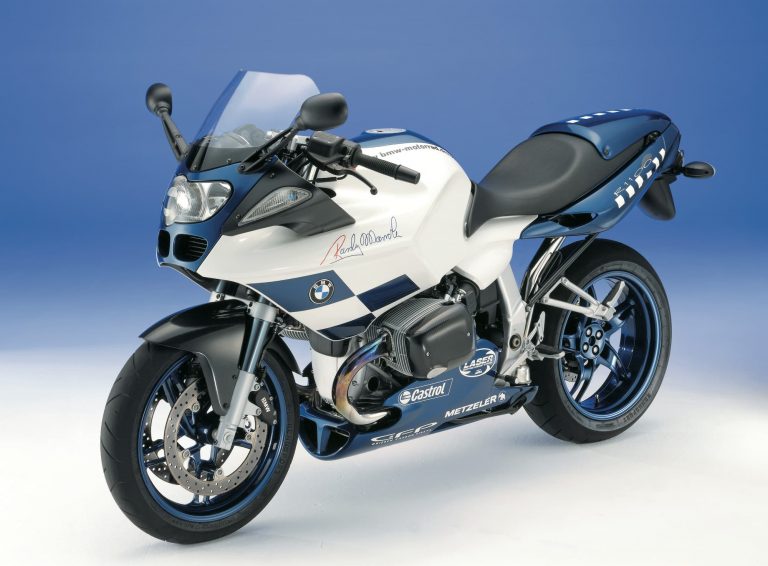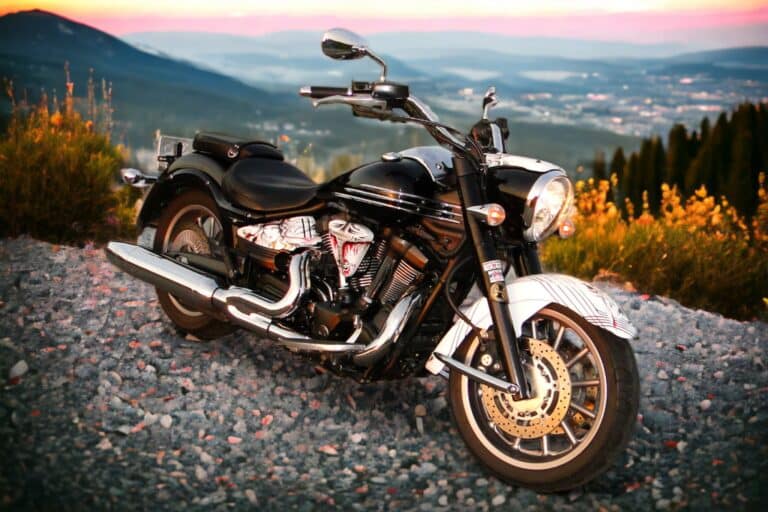Triumph Tiger 800 (2018-2019, including XC and XR range) Maintenance Schedule
This is the maintenance schedule with associated service intervals for the Triumph Tiger 800 motorcycles from 2018-2019.
In 2018, Triumph updated its Triumph Tiger 800 line (they also updated the Triumph Tiger 1200 line).
The new models included the Triumph Tiger 800 XCa, XCx, XR, XRa, and the XRx LRH or Low Ride Height. All of them share the same 800cc three-cylinder engine, which with an 11.3:1 compression ratio makes a peak of 70 kW (94 bhp) at 9500 rpm, or 79 Nm (58 ft-lb) @ 8050 rpm. But they all differ in brakes, suspension, and tech.
Here are the differences between the Triumph Tiger 800 models in brief:
| Spec level | Road | Adventure |
|---|---|---|
| Base | XR — 19-inch cast front wheel, Showa suspension, Nissin calipers, no TFT | XC — 21-inch spoked front wheel. Not available in all markets. |
| Mid | XRx — Brembo front calipers, Full colour TFT, five position screen, four riding modes, DRLs, cruise control, centre stand. LRH version also available | XCx — Brembo front calipers, 21-inch spoked front wheel, adjustable WP long-travel suspension, DRLs, cruise control, Off-road Pro riding mode |
| Top | XRt — Adjustable front suspension, Programmable ride mode, LED lighting, heated seat and grips | XCa — Top spec. LED lighting, heated seat and grips, programmable ride mode, more screen styles, rad guard |
In 2020, Triumph released the Triumph Tiger 900 series of motorcycles, replacing the Triumph Tiger 800 series.
This site has links for things like oil and spark plugs from which we earn a commission (which unfortunately nobody can save, not even us). If you appreciate this work, then please use those links. Thanks!
Triumph Tiger 800 Service Intervals
Generally, the 2018-2019 Triumph Tiger 800 range has a 6000 mi / 10000 km or annual service interval. At every service, you change the oil and oil filter, balance the throttle bodies, and run through a host of checks.
The major service interval for the Triumph Tiger 800 is every 12000 miles or 20000 km (with no time interval). At the major service, check the valve clearances, change the spark plugs, and change the air filter.
Triumph also recommends a one-off camshaft timing adjustment at the first major service.
Since the Tiger 800 is liquid-cooled, you do need to keep the coolant fresh, replacing it every 3 years with Triumph HD4X or an equivalent.
And Triumph recommends changing the fork oil every 24000 miles or 40000 km.
Finally, keep the brake fluid fresh — change it every 2 years.
What you need to maintain the Triumph Tiger 800 series
Consult the below maintenance schedule to see what you might need, e.g. oil, spark plugs, etc. You can find part numbers that we’ve researched to help out.
| Component | Triumph Tiger 800 Spec |
|---|---|
| Oil | Triumph recommends 10W/40 or 10W/50 semi or fully synthetic motorcycle engine oil that meets specification API SH (or higher) and JASO MA, such as Castrol Power 1 Racing 4T 10W-40 (fully synthetic) engine oil, sold as Castrol Power RS Racing 4T 10W-40 (fully synthetic) in some countries. |
| Oil filter | Replace the oil filter every time you change the oil. Use Triumph part number T1218001. You can also use the Hiflofiltro HF204RC. |
| Brake fluid | Triumph motorcycles need DOT 4 brake fluid (they have a clutch cable, so you don’t need fluid for the clutch). Use Castrol DOT 4. |
| Coolant | Triumph recommends HD4X, a HOAT coolant. You can also get one of these alternatives to Triumph HD4X. |
| Front brake pads | Standard brake pads code is T2021330 (LH) and T2021340 (RH). The equivalent part number for EBC brakes is FA181HH for the 2018+ Triumph Tiger 800. |
| Rear brake pads | Use original part number T2025016. The equivalent part number for EBC brakes is FA140HH. |
| Spark plugs | NGK code CR9EK. Note they’re sold individually. Make sure they’re gapped to 0.9mm with an appropriate spark plug gap tool. |
| Air filter | The part number for the air filter is T2200557. You can also use K&N part TB-8011, which is generally more available and cheaper. |
Maintenance Schedule for Triumph Tiger 800 motorcycles
Below is the maintenance information from the Triumph Tiger 800 maintenance schedule.
For convenience it’s broken into three parts:
- Daily / Pre-ride checks
- Chain maintenance
- Periodic maintenance
Daily checks
| Tiger 800 — Daily / Pre-ride checks |
|---|
| Oil cooler – check for leaks |
| Fuel system – check for leaks, chafing etc. |
| Cooling system – check for leaks |
| Coolant level – check/adjust |
| Clutch cable – check/adjust (Protect all cable life) |
| Wheels – inspect for damage |
| Spoked wheels (if fitted) — check for broken or damaged spokes, and spoke tightness |
| Tyre wear/tyre damage – check |
| Tyre pressures – check/adjust |
| Lights, instruments, and electrical systems – check |
| Steering – check for free operation |
| Forks – check for leaks/smooth operation |
| Brake pads – check wear levels (FA181HH, FA140HH) |
| Brake master cylinders – check for fluid leaks |
| Brake calipers – check for fluid leaks and seized pistons |
| Brake fluid levels – check |
| Drive chain slack – check/adjust |
| Drive chain rubbing strip – check |
| Fasteners – inspect visually for security |
| Bank angle indicators – inspect visually for wear |
| Side stand – check operation |
| Centre stand (if fitted) – check operation |
Periodic (Regular) maintenance schedule
The following is the list of maintenance operations and to be done on this motorcycle with a distance or time interval — whichever comes earlier.
Notes:
- At the end of the service schedule, keep following it in the pattern shown.
- The break-in service is omitted as this isn’t a current model.
- Items marked [T] need special Triumph tools.
| mi x 1000 | 6 | 12 | 18 | 24 | |
|---|---|---|---|---|---|
| km x 1000 | 10 | 20 | 30 | 40 | Every |
| Engine oil – renew (Castrol Power 1 Racing 4T 10W-40) | ✓ | ✓ | ✓ | ✓ | Year |
| Oil filter – renew (HF204RC) | ✓ | ✓ | ✓ | ✓ | Year |
| Throttle body plate (butterfly) – check/clean | ✓ | ✓ | ✓ | ✓ | |
| [T] Autoscan — carry out full Triumph diagnostic scan (if you have the gear) | ✓ | ✓ | ✓ | ✓ | Year |
| [T] ABS modulator – check for stored DTCs | ✓ | ✓ | ✓ | ✓ | Year |
| Secondary air injection system – check/clean | ✓ | ✓ | |||
| Air filter – renew (TB-8011) | ✓ | ✓ | |||
| Throttle bodies – balance | ✓ | ✓ | ✓ | ✓ | |
| Fuel hoses – renew | 4 years | ||||
| Evaporative loss hoses (if fitted) – renew | 4 years | ||||
| Spark plugs – check | ✓ | ✓ | |||
| Spark plugs – renew (NGK CR9EK) | ✓ | ✓ | |||
| Coolant – renew (HD4X or an equivalent) | 3 years | ||||
| Camshaft timing – adjust | ✓ | At 12000 mi (20000 km) service only | |||
| Wheel bearings – check for wear/smooth operation | ✓ | ✓ | ✓ | ✓ | Year |
| Fork oil – renew | ✓ | ||||
| Headstock bearings – check/adjust | ✓ | ✓ | ✓ | ✓ | Year |
| Headstock bearings – lubricate | ✓ | ✓ | |||
| Rear suspension linkage – check/lubricate | ✓ | ✓ | |||
| Brake fluid – renew (Castrol DOT 4) | 2 years | ||||
| Drive chain rubbing strip – renew | ✓ | ✓ | ✓ | ✓ | |
| Accessory rack sliding carriage – check for correct operation (if fitted) | ✓ | ✓ | ✓ | ✓ | Year |
| Centre stand flanged sleeves – check/clean/grease (lithium soap-based grease) | ✓ | ✓ | ✓ | ✓ | Year |
| Accessory pannier link mechanism – check for correct operation and adjustment (if fitted) | ✓ | ✓ | ✓ | ✓ | Year |
Chain maintenance on the Tiger 800
The drive train is a critical part of the Tiger 800’s everyday performance because it’s a bike people tend to use in all kinds of conditions — rain, mud, and even snow.
Follow the below basic maintenance schedule for the chain of the Tiger 800.
| Operation | Every |
|---|---|
| Drive chain – wear check | 500 miles (800 km) |
| Drive chain – lubricate (Motul chain paste) | 200 miles (300 km) |
Checking drive wear
There are a few things to check when checking the Tiger 800’s drive chain wear.
- Sprocket general condition: Check to make sure the teeth of the two sprocket and driven gear are in good condition — not worn, cracked, or chipped.
- Chain condition: Make sure the chain isn’t rusty, or worn in a way that makes it stiff in parts.
- Chain length: Hang a 10-20 kg (20-40 lb) weight on the chain, and Measure the length of 20 links of the straight part of the chain — in a few spots if possible. Measure the length from the pin centre of the 1st pin to the pin centre of the 21st pin. If it’s longer than 319 mm, the chain is worn and must be replaced.
You also need to regularly set the chain tension, a.k.a. chain slack (which Triumph calls the “drive chain free movement”).
You inspect this by measuring the free vertical movement of the chain midway between the sprockets. Do the test a few times in different parts if it’s necessary.
- Target free drive chain movement (chain slack): 20-30 mm
To adjust the chain tension:
- Undo the rear axle bolts
- Loosen the lock nuts on both sides
- Move the adjuster nuts by an equal amount (usually anticlockwise, to tighten the chain up)
- Push the wheel into firm contact with the adjusters
- Tighten the lock nuts to 20 Nm (13 lb-ft)
- Tighten the rear wheel axle bolts to 110 Nm (80 lb-ft).
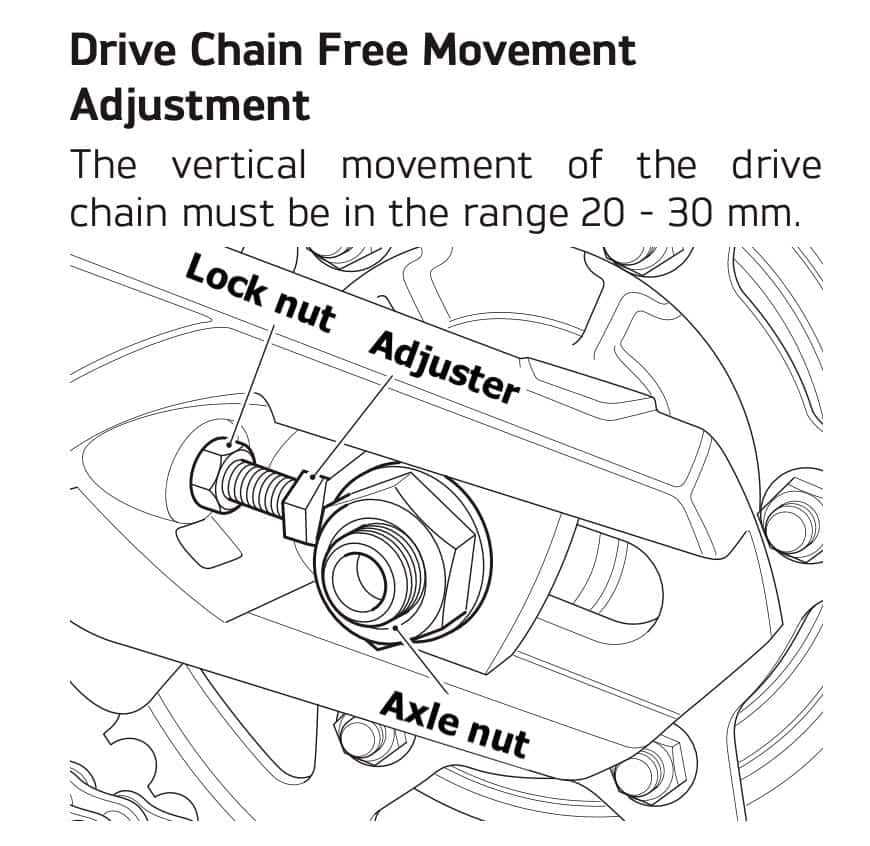
Wheel and Tire specs / Pressures
The Triumph Tiger XR and XC models have different wheels and tire types. See the below table for the specifications, as well as the recommended starting pressures.
| Tiger 800 (2018-2019) | Wheel type | Rear tire type | Front tire size | Rear tire size |
|---|---|---|---|---|
| Tiger XR models | Cast | Tubeless | 100/90-19 M/C 57V | 150/70 R17 M/C 69V |
| Tiger XC models | Spoked | Tube-type | 90/90-21 M/C 54V | 150/70 R17 M/C 69V |
However, all models of Tiger 800 have the same recommended baseline tire pressure when cold.
| Wheel | Tire Pressure (cold) |
|---|---|
| Front | 2.5 bar / 250 kPa / 36 psi |
| Rear | 2.9 bar / 290 kPa / 42 psi |
About the Triumph Tiger 800 (2018-2019)

The Triumph Tiger 800 is one of Triumph’s long-serving lines of middleweight adventure sports/touring motorcycles. They have been very popular as a smooth-running, fun to ride, and adventure-ready middleweight for a long time, alongside bikes like the BMW F 800 GS, but with a unique three-cylinder engine.
The Triumph Tiger 800 had been around since 2010, but Triumph totally rebuilt the line in 2018 (just shortly before releasing the Triumph Tiger 900 line, too).
The Triumph Tiger 800 is fundamentally the same motorcycle — a well-specified sporty 800cc inline triple in an upright adventure-ready chassis. The revised tuning makes for a very responsive engine that makes 65 kW (94 hp) of power.
Triumph does three-cylinder engines well. The Tiger may be an adventure or adventure sports motorcycle, but the sound of a Triumph triple getting up there in revs is very energising, despite the chassis. You’re not on a Speed Triple, but you don’t feel bored by the motor, as can happen on some adventure bikes.
There are a number of incarnations of Triumph Tiger 800, in different spec levels. The letters can get confusing. But the core thing to remember is that
- The XR (the “R” for “Road”) is the road-ready version, with cast wheels and Showa normal travel suspension, and
- The XC (the “C” for “Country”, not officially but as a mnemonic) is the cross country/adventure bike, with spoked wheels (and a larger one 21-inch wheel up front) and longer-travel WP suspension.
The XR has a base model, but the XC only comes in mid-spec and higher spec versions in most markets.
Even though the XR and XC have different stated intended uses, the XR versions acquit themselves decently off-road on dirt roads. If you’re going to be hitting gnarly 4WD tracks, then you probably would feel more comfortable on the XC versions with its significantly longer suspension.
There are many improvements in the 2018-2019 Triumph Tiger 800. A few of these are
- Higher-spec Brembo front brakes (on all but the lowest base model XR)
- A shorter ratio first gear
- Riding modes with a new Off Road Pro riding mode on the XC range
- Redesigned switchgear, with illuminated buttons on the top-shelf ones
- A lighter, freer-flowing exhaust
- TFT display
- LED lighting
- Better comfort (with handlebars moved a subtle 10mm back, and a higher windscreen)
Like many modern motorcycles, the Triumph Tiger 800 series are fly-by-wire. This means they get a number of riding modes, which can include up to six — Road, Off-road, Rain, Sport, Off-road Pro, and Custom. You get more or less depending on your spec level. In terms of maintenance, the modern Tiger 800 doesn’t have a throttle cable to lubricate.
You can also change your ABS or TC levels, but only when you’ve stopped.
The Triumph Tiger 800 models aren’t lightweight (they’re circa 225-230 kg fully loaded), but they don’t feel heavy, especially compared to their bigger siblings the Triumph 1200 range.
For most adventure riding and most adventure riders, the smaller adventure bikes are the more practical choice, which is partly why they’re becoming so popular. Luckily, with fun motors like the triple in the Tiger, you don’t give up any enjoyment in the process.
Reference — Manual for the Triumph Tiger 800 (2018-2019)
The above maintenance schedule comes directly from the user’s manual for the Triumph Tiger 800, which is available on the Triumph web site.
The same manual is provided for every motorcycle in the range. See screenshots below







